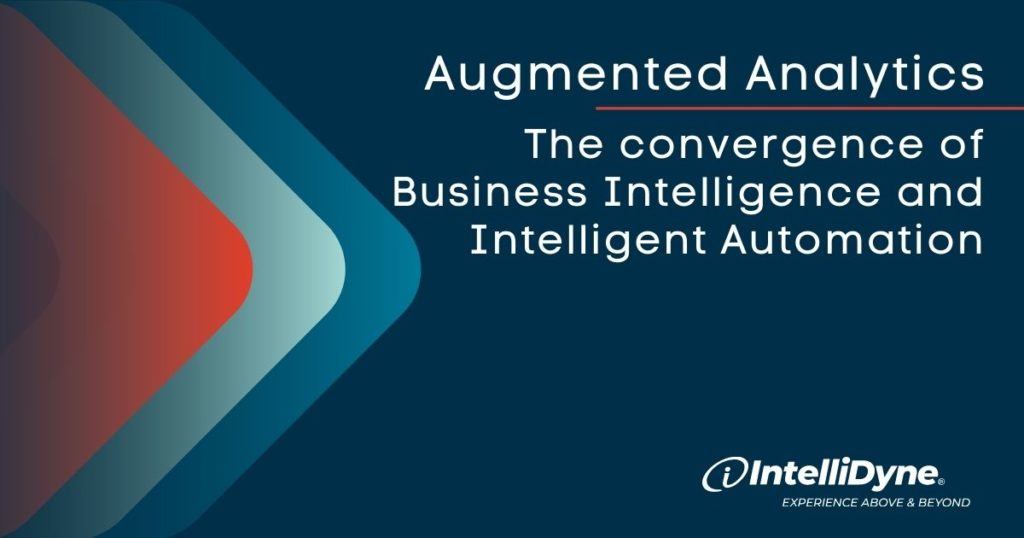Augmented Analytics solutions enable decision makers and analysts to quickly get to the point of their analysis and automate ‘next-step’ actions to be taken using intelligent automation, which is the convergence of Artificial Intelligence (AI), Business Intelligence (BI), Machine Learning (ML) and Robotic Process Automation (RPA) technologies.
Nearly every organization uses BI tools to develop dashboards that report what happened. Augmented Analytics enables decision makers and analysts to understand why by applying filters to dig deeper, finding events meeting certain criteria of interest, and ultimately prescribing actions to take next. Through the integration of powerful BI, AI, ML and RPA technologies, Augmented Analytics takes traditional BI dashboards to the next level, improving the speed and quality of decision making, and even automating the required next steps. It shifts valuable resources away from finding the what to learning the why.
Eliminating the hay to pinpoint the needle
Augmented Analytics automatically correlates relevant data to aid rapid discovery, reveal concealed areas requiring deeper analysis, and deliver those insights to decision makers faster than traditional BI. The integrated technologies can instantaneously uncover hidden events or conditions such as fraud, customer churn, health conditions, or component failure. Using machine learning approaches to identify these events allows decision makers to act on them immediately, effectively eliminating laborious discovery efforts to allow more time for addressing the root cause.
Traditional data discovery applications and dashboards are thus extended by integrating automation to narrow the aperture and pinpoint areas of focus. In other words, instead of forcing decision makers to find needles in the haystack based on hunches and applying data filters, Augmented Analytics embeds machine learning and AI into BI applications that effectively expose the needles by removing the hay. What’s more, the integrated solution’s use of conversational analytics and natural language processing (NLP) makes data science more accessible to a wider range of users and decision makers. This increased accessibly allows users without data science expertise to consume and effectively use data, allowing more areas of organizations to benefit from Analytic Solutions.
Gartner estimates that by 2021, conversational analytics and natural language processing (NLP) will boost analytics and BI adoption from 32% of employees to more than 50% of an organization’s employees, to include new classes of users — particularly in front offices
Potential candidates for Augmented Analytics include investigative use cases, or ones that follow the simple pattern of a) isolating a problem or area of interest within a large data set, and b) taking a prescribed action. Examples of investigative applications include fraud, waste, and abuse investigations, intelligence, root cause analysis, IT and cyber incident management, and decision-based use cases that require human involvement to evaluate and approve automated actions.
An example of Augmented Analytics in action
A good example of Augmented Analytics use is fraud detection. Typically, a fraud investigator will pore over large amounts of information to assess the likelihood of fraud in the form of improper payments. Once the investigator has determined that there is a reasonable assumption that fraudulent payments have been made or received, the investigator will be required to open a case in the agency’s case management system.
Using an Augmented Analytics solution, potential fraud candidates are scored on the probability of fraud using a machine learning algorithm, and the dashboard only presents these potential cases to the investigator. If needed, the investigator can drill into the data using the BI portion of the solution. When the investigator has completed their assessment, in one click, a robotic process can open and populate new cases in the case management system, saving hundreds of hours of manual labor, helping to eliminate backlogs.
Steps for implementing an Augmented Analytics use case
- First, identify use cases in your organization that follow the a-b pattern outlined above. Remember, if you are currently using a BI tool that you’ve created as a decision support tool, ask yourself what action would you normally take (depending on specific use case conditions) that your dashboard was constructed to identify and address.
- Isolate the decision criteria you are using to determine whether a condition presented in the data qualifies as needing an action to be taken. Develop your AI or machine learning around these conditions to pre-process or dynamically tag your data with probability scores or action events.
- Document those actions, looking for repetitive, systematic processes that can be replicated using RPA software tools.
- Integrate all of the above into a single solution so that the decision maker is presented with the opportunity to review use cases requiring action from a single point of reference. Action is invoked by the decision maker simply by clicking a button that launches the sequence of next steps and actions to resolve or address the condition. This keeps the human in the loop but removes the tedious, time-consuming manual tasks.
Transparency and trust
IntelliDyne has successfully taken this process and compressed it into a highly automated workflow. We understand how important it is to gain users’ trust in new applications and systems, which is why we explain technologies in ways that are relevant and uncomplicated. We emphasize transparency and understanding so that our users have high confidence in the solutions. Contact us and we’ll be happy to continue the conversation with your stakeholders.

